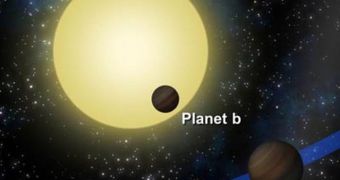Following in the footsteps of French mathematician Urbain Le Verrier, who predicted the existence of Neptune by analyzing small deviations in Uranus' orbit around 150 years ago, a team of astronomers has recently been able to infer the existence of a second exoplanet in a system where only one was visible.
Investigators led by Southwest Research Institute (SwRI) expert Dr. David Nesvorny make up the first team to discover an alien world outside the solar system through this research technique. Details of how the research was conducted appear in the latest online issue of the top journal Science.
The team used gravitational perturbation theory and complex computational methods to develop a simulation explaining the gravitational effects they were seeing on the visible exoplanet in the star system KOI-872. The designation KOI refers to a Kepler Object of Interest.
These objects were flagged by the NASA Kepler Telescope, a scientific satellite launched specifically to discover Earth-like worlds around distant stars. Thus far, the mission has returned more than 2,300 results. Astronomers have confirmed more than 750 exoplanets until now.
“Today’s telescopes are detecting planets around distant stars, and NASA’s Kepler Telescope, launched in 2009, is a champion among them,” Nesvorny explains. NASA experts say that the planet-hunting telescope is constantly monitoring more than 150,000 stars in a narrow portion of the sky.
In time, subtle variations in the brightness of these stars occur. These minute shifts can be indicative of an exoplanet moving in between the telescope and its targets. In order to confirm an alien world, Kepler needs to observe at least three passes.
“For a planet following a strictly Keplerian orbit around its host star, the spacing, timing and other properties of the observed transit light curve should be unchanging in time,” Harvard-Smithsonian Center for Astrophysics (CfA) expert and second paper author, Dr. David Kipping, explains.
“Several effects, however, can produce deviations from the Keplerian case so that the spacing of the transits is not strictly periodic,” he adds. A hidden exoplanetary companion can produce such an effect, Astrobiology Magazine reports.
Its gravity can pull on the other planets, making them deviate from their courses slightly. Some stellar transits can therefore be delayed in respect to the others. By analyzing these variations, the team was able to infer the existence of an unseen planet in the KOI-872 system.
“It quickly became apparent to us that a large hidden object must be pulling on the transiting planet. To put this in context, if a bullet train arrives in a station two hours late, there must be a very good reason for that. The trick was to find what it is,” Nesvorny concludes.

 14 DAY TRIAL //
14 DAY TRIAL //